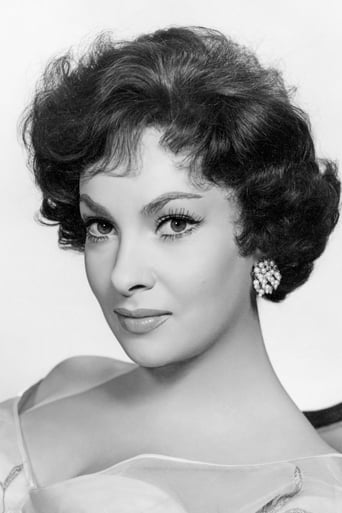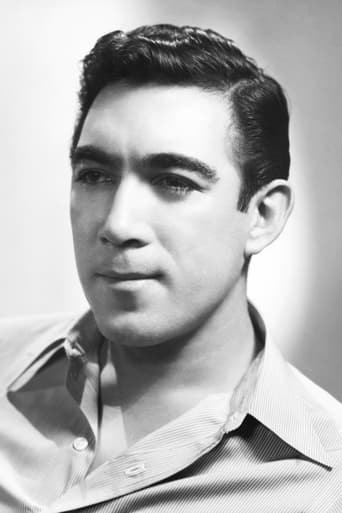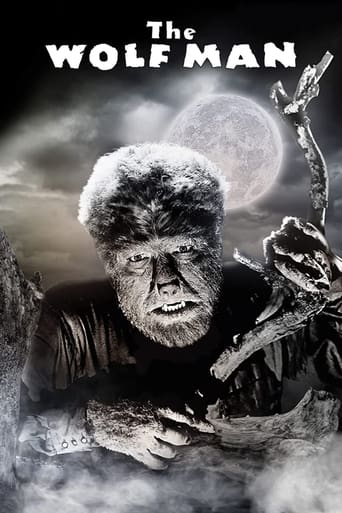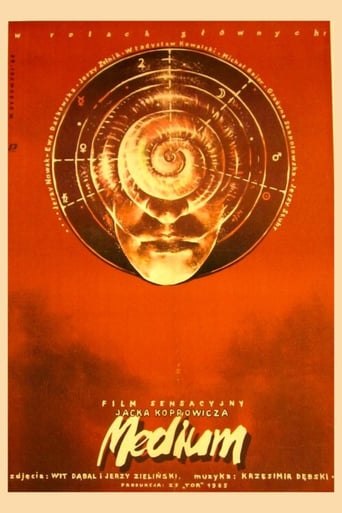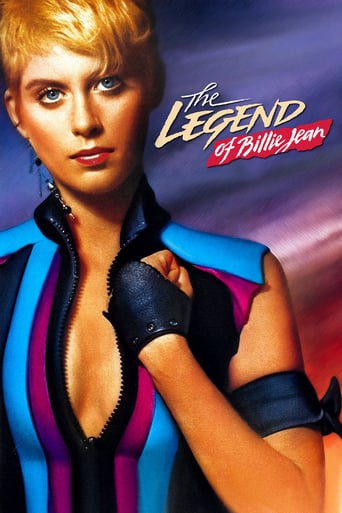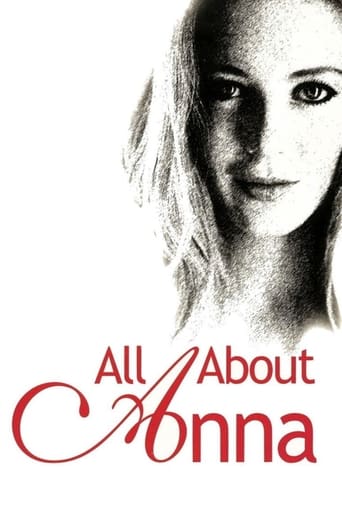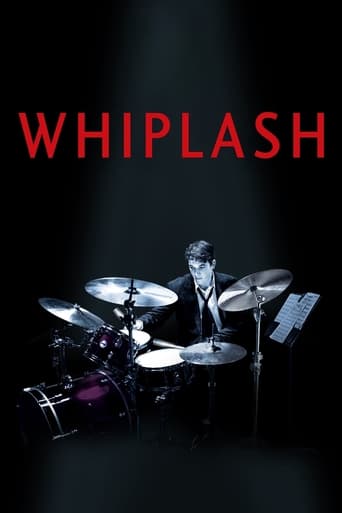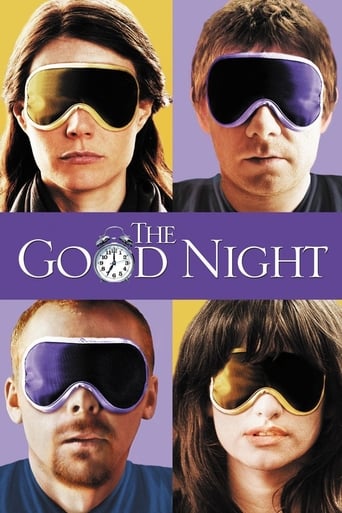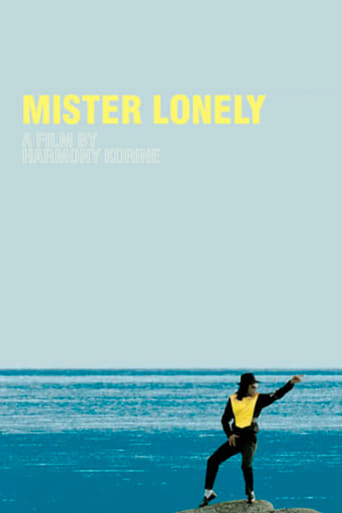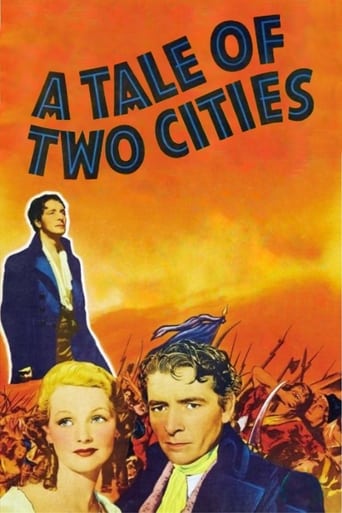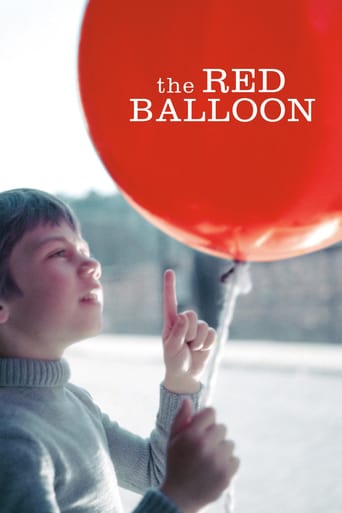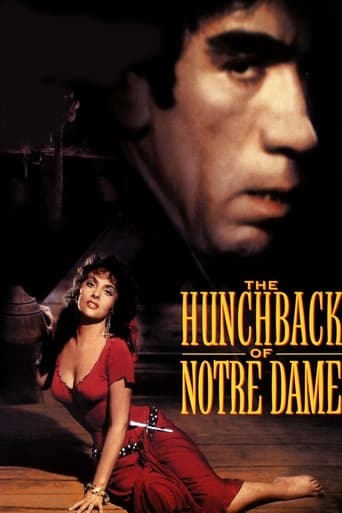

The Hunchback of Notre Dame (1957)
Paris, 1482. Today is the festival of the fools, taking place like each year in the square outside Cathedral Notre Dame. Among jugglers and other entertainers, Esmeralda, a sensuous gypsy, performs a bewitching dance in front of delighted spectators. From up in a tower of the cathedral, Frollo, an alchemist, gazes at her lustfully. Later in the night, Frollo orders Quasimodo, the deformed bell ringer and his faithful servant, to kidnap Esmeralda. But when the ugly freak comes close to her is touched by the young woman's beauty...
Watch Trailer
Cast


Similar titles
Reviews
The Hunchback of Notre Dame is a very hard film to make. Mostly due to the darkness and despair of the original work. If you've only grown up with the Disney version, prepare to be shocked. I truly liked this effort, as it got a lot of the complexities of each character down. Frollo is a man of religion but also science. His faith and logical mind battling it out as he experiences lust. Esmerelda is a victim of her own beauty, but also plays a hand in her own downfall. She doesn't understand her power over men which leads to her angering of the males. Quasimodo is portrayed as not so much an outcast here. He is known by all, but is awkward and unaware of his strength. This is a film where everyone is guilty for their actions, which also makes them all sympathetic. The design of the film is often too much. WIth so many colors and such production put in it comes across as an over the top school production. Less can be more, but with the final heart wrenching scene, you'll probably be left as an emotional wreck.
In 1482, in the Feast of Fools in Paris, the deformed bell ringer Quasimodo (Anthony Quinn) is elected the King of Fools. After the party, the evil alchemist Master Claude Frollo (Alain Cuny), who has a repressed lust for the kind gypsy dancer Esmeralda (Gina Lollobrigida), orders his servant Quasimodo to abduct the beautiful youngster. However, she is rescued by Captain Phoebus (Jean Danet) and Quasimodo is sentenced to be whipped in the square of Notre Dame and Esmeralda gives water to him. Later Esmeralda goes with Captain Phoebus to a room in an inn to spend a night of love together. However, Frollo is stalking her and uses her stiletto to stab Phoebus on his back, and Esmeralda takes the blame and is sentenced to be hanged. But Quasimodo brings Esmeralda to the sanctuary of Notre Dame and expresses his love for the gypsy."The Hunchback of Notre Dame" is one of the cruelest romances of the literature and cinema history in a dark age in French history. In this version of this sad tale of injustice, Anthony Quinn is awesome with a memorable performance and Gina Lollobrigida is perfect in the role of the seductive gypsy. My vote is seven.Title (Brazil): "O Corcunda de Notre Dame" ("The Hunchback of Notre Dame")
The opening of this film – relating the finding of the word 'Ananké' (which the English-language narrator irritatingly mispronounces as 'Anankh'!) on the wall of the cathedral – signals that Jean Delannoy has given us the best cinema version of 'Notre Dame de Paris' yet. It is the closest in spirit to the book in picaresque colour and in its final tragedies. *Some spoilers follow, comparing the book and the film, and touching upon other film adaptations.* While international distribution (especially in the US) meant that Delannoy still had to fudge Claude's priesthood (being addressed as "Maître/Master Frollo"), his sober dress and the fact he works in Notre Dame make it implicit – indeed, obvious to anyone familiar with the book, as French audiences are. His younger brother Jehan is thus restored to his (im)proper and impish self as a wastrel student (Maurice Sarfati), who first appears dressed as an imp for the Feast of Fools. (In the 1923 and 1939 versions, Jehan became a middle-aged substitute for his brother in his relationship with Esméralda.) There are, nevertheless, differences between the French and English versions. Because of the Hays Code, Quasimodo is made *King* of Fools, *not* Pope, in the English dub, the scene being shot with two different crowns. The French version also includes scenes with Pierre after Esméralda's arrest, and an extended scene of Claude's breakdown, returning to La Falourdel's, corresponding to the book's chapter 'Fièvre' – presumably cut because the English title overemphasises Quasimodo.Anthony Quinn and Gina Lollobrigida have top billing, but Alain Cuny quietly dominates the film – as he should. Claude, not Quasimodo, is the most interesting central character: the brilliant, tormented scholar and scientist as Romantic tragic hero/anti-hero. Although over a decade too old for the role, Cuny has the right air of anguished intensity and self-destructive passion. Even as he brings suffering on others, he himself suffers still more deeply, all haunted eyes and strong cheekbones. (An acquaintance observed his hairstyle is too 1950s, but the anachronism is less significant than the fact he has so much hair at all: book-Claude's hair has receded into his tonsure!) This is the only film version that shows his alchemical researches, and sets Louis XI's incognito visit, as 'Compère Tourangeau', in his laboratory, rather than in his rooms in the cloisters. This atmospheric scene captivated me when I first saw the film on TV as a child, and as a teenager I fell in love with Claude in the book (recognising a fellow-Aspie). My chief regret is that (as usual) the passionate confrontation in prison from 'Lasciate Ogni Speranza' is omitted: this Claude is certainly handsome enough for some chest-baring cassock-ripping He gives us the film's most memorable moments: his rapt face framed by the broken window of the Grande Salle of the Palais de Justice, while in the adjacent pane we see the reflection of what grips his attention – Esméralda dancing; how he intones her name over his experiments (which reminds me of Ezra Pound's marvellous 'The Alchemist: Chant for the Transmutation of Metals': "Midonz, gift of the God, gift of the light,/gift of the amber of the sun,/Give light to the metal"); his torment at La Falourdel's, watching Phoebus (Jean Danet, suitably smug and flashy) seduce Esméralda; scratching 'Ananké' on the wall, watched by an uncomprehending Quasimodo; returning to the cathedral by moonlight, and crossing himself (cut from the English-language dub) when he sees Esméralda in ghostly white. In his last moments, he stretches out his arms, crucified by his forbidden desires, before falling. It is a superb performance, unshowy, but emotionally wrenching.Gina Lollobrigida is somewhat mature and overtly sexy to be entirely convincing as a virginal teenager, but she has glamour, vitality, and (with choreography by Myasin/Massine) dances better than most screen Esméraldas. It is believable that an otherwise ascetic and intellectual priest could be driven to crime and madness for such a beauty. Of course, with such a bright and spirited Esméralda, the question remains as to how she can be so stupid as to fall for Phoebus's smarmy charms, but that is part of the tragedy of the book – and, indeed, such calamities happen in life. Her comic relationship with Pierre Gringoire (Robert Hirsch) is delightful, with a very cute Djali as the third party in their 'marriage'. It is wonderful to see so much of Pierre, without him being rewritten as a conventional romantic lead (as in 1939 and 1982). Clopin is played somewhat younger than usual by Philippe Clay: Villon-esque, a figure from Bosch or Breughel. Quinn is the best film Quasimodo: alarming and touching by turns, unsentimentalised, and believable. Unlike Chaney or Laughton, whose deformities were far too exaggerated, he looks as if he could have survived childhood in 15C. He is deaf, and seems to have learning disabilities, as the book implies. Fleur-de-Lys (Danielle Dumont) and her friends, in their henins and colourful gowns, look as if they could have stepped out of an illuminated manuscript. Phoebus is as obnoxious and shallow as written: only in the English dub is he softened slightly by being made to regret that he could not have saved Esméralda himself.The last part of the story is truncated because of the running-time, hence the change in the events at the Bastille, and in the circumstances of Esméralda and Clopin's deaths. However, it is still far more effective than the bowdlerised 'happier' endings imposed by the 1923, 1939, 1982, 1996 and 1997 versions. The conclusion at Montfaucon is retained, and is movingly portrayed. All in all, this is a thoroughly enjoyable film, which gives a better impression of the novel than any other cinema adaptation to date, and confirms my belief that French literature usually fares best in the hands of French film-makers.
No matter if critics seem to prefer the 1939 version of THE HUNCHBACK OF NOTRE DAME, I thoroughly enjoy this one. Anthony Quinn avoids taking the Laughton path and doing Quasimodo as a monster; his is a painfully realistic performance. Gina Lollobrigida is ever so beautiful as Esmeralda. Her gypsy is a young woman who is "a queen", as her fellow Court of Miracle friends know very well. She is sensual and yet decent and pure in her actions, even as she gives herself to Phoebus. The great cast includes several legendary French actors (Valentine Tessier, Alain Cuny, Madeleine Barbulee, among others). The final scenes are indeed touching, especially in the Italian version, in which Lollobrigida speaks in her native language. A must see.


